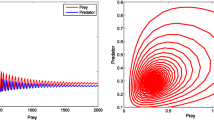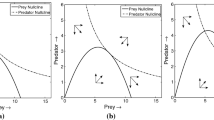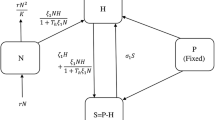Abstract
Allee effect in population dynamics has a major impact in suppressing the paradox of enrichment through global bifurcation, and it can generate highly complex dynamics. The influence of the reproductive Allee effect, incorporated in the prey’s growth rate of a prey–predator model with Beddington–DeAngelis functional response, is investigated here. Preliminary local and global bifurcations are identified of the temporal model. Existence and non-existence of heterogeneous steady-state solutions of the spatio-temporal system are established for suitable ranges of parameter values. The spatio-temporal model satisfies Turing instability conditions, but numerical investigation reveals that the heterogeneous patterns corresponding to unstable Turing eigenmodes act as a transitory pattern. Inclusion of the reproductive Allee effect in the prey population has a destabilising effect on the coexistence equilibrium. For a range of parameter values, various branches of stationary solutions including mode-dependent Turing solutions and localized pattern solutions are identified using numerical bifurcation technique. The model is also capable to produce some complex dynamic patterns such as travelling wave, moving pulse solution, and spatio-temporal chaos for certain range of parameters and diffusivity along with appropriate choice of initial conditions. Judicious choices of parametrization for the Beddington–DeAngelis functional response help us to infer about the resulting patterns for similar prey–predator models with Holling type-II functional response and ratio-dependent functional response.










Similar content being viewed by others
Data availability statement
The authors declare that the manuscript has no associated data.
References
Aguirre P, González-Olivares E, Sáez E (2009) Three limit cycles in a Leslie–Gower predator-prey model with additive Allee effect. SIAM J Appl Math 69(5):1244–1262
Ai S, Du Y, Peng R (2017) Traveling waves for a generalized Holling–Tanner predator–prey model. J Differ Equ 263(11):7782–7814
Al Saadi F, Champneys A (2021) Unified framework for localized patterns in reaction-diffusion systems; the Gray–Scott and Gierer–Meinhardt cases. Philos Trans R Soc A 379(2213):20200277
Al Saadi F, Champneys A, Gai C et al (2022) Spikes and localised patterns for a novel Schnakenberg model in the semi-strong interaction regime. Eur J Appl Math 33(1):133–152
Allee W (1931) Animal aggregations: a study in general sociology. University of Chicago Press, Chicago
Alonso D, Bartumeus F, Catalan J (2002) Mutual interference between predators can give rise to Turing spatial patterns. Ecology 83(1):28–34
Alves M, Hilker F (2017) Hunting cooperation and Allee effects in predators. J Theor Biol 419:13–22
Banerjee M, Petrovskii S (2011) Self-organised spatial patterns and chaos in a ratio-dependent predator-prey system. Theor Ecol 37–53
Banerjee M, Volpert V (2016) Prey-predator model with a nonlocal consumption of prey. Chaos Interdiscip J Nonlinear Sci 26(8):083120
Banerjee M, Volpert V (2017) Spatio-temporal pattern formation in Rosenzweig–Macarthur model: effect of nonlocal interactions. Ecol Complex 30:2–10
Banerjee M, Mukherjee N, Volpert V (2020) Prey-predator model with nonlocal and global consumption in the prey dynamics. Discrete Contin Dyn Syst S 13(8):2109
Beddington JR (1975) Mutual interference between parasites or predators and its effect on searching efficiency. J Animal Ecol 331–340
Belyakov L, Glebsky LY, Lerman L (1997) Abundance of stable stationary localized solutions to the generalized 1d Swift–Hohenberg equation. Comput Math Appl 34(2–4):253–266
Berec L, Angulo E, Courchamp F (2007) Multiple Allee effects and population management. Trends Ecol Evolut 22(4):185–191
Boukal D, Berec L (2002) Single-species models of the Allee effect: extinction boundaries, sex ratios and mate encounters. J Theor Biol 218(3):375–394
Brodie JED, Ridenhour B III, Brodie E (2002) The evolutionary response of predators to dangerous prey: hotspots and coldspots in the geographic mosaic of coevolution between garter snakes and newts. Evolution 56(10):2067–2082
Burke J, Knobloch E (2007) Snakes and ladders: localized states in the Swift–Hohenberg equation. Phys Lett A 360(6):681–688
Cangelosi R, Wollkind D, Kealy-Dichone B et al (2015) Nonlinear stability analyses of turing patterns for a mussel-algae model. J Math Biol 70(6):1249–1294
Champneys A (1998) Homoclinic orbits in reversible systems and their applications in mechanics, fluids and optics. Physica D 112(1–2):158–186
Chowdhury PR, Petrovskii S, Banerjee M (2021) Oscillations and pattern formation in a slow-fast prey–predator system. Bull Math Biol 83(11):1–41
Courchamp F, Berec L, Gascoigne J (2008) Allee effects in ecology and conservation. OUP Oxford, Oxford
Cross M, Hohenberg P (1993) Pattern formation outside of equilibrium. Rev Mod Phys 65(3):851
Dennis B (1989) Allee effects: population growth, critical density, and the chance of extinction. Nat Resour Model 3(4):481–538
Dey S, Banerjee M, Ghorai S (2022a) Analytical detection of stationary Turing pattern in a predator-prey system with generalist predator. Math Model Nat Phenom 17:33
Dey S, Banerjee M, Ghorai S (2022b) Bifurcation analysis and spatio-temporal patterns of a prey-predator model with hunting cooperation. Int J Bifurc Chaos 32(11):2250173
Ducrots A, Langlais M (2012) A singular reaction–diffusion system modelling prey-predator interactions: invasion and co-extinction waves. J Differ Equ 253(2):502–532
Dunbar S (1983) Travelling wave solutions of diffusive Lotka–Volterra equations. J Math Biol 17(1):11–32
Ermentrout B, Mahajan A (2003) Simulating, analyzing, and animating dynamical systems: a guide to xppaut for researchers and students. Appl Mech Rev 56(4):B53–B53
Fryxell J, Lundberg P (2012) Individual behavior and community dynamics, vol 20. Springer, Berlin
Fryxell J, Sinclair A, Caughley G (2014) Wildlife ecology, conservation, and management. Wiley, New York
Gascoigne J, Lipcius R (2004) Allee effects driven by predation. J Appl Ecol 41(5):801–810
Hale J (2010) Asymptotic behavior of dissipative systems. American Mathematical Society, New York
Hayase Y, Ohta T (2000) Self-replicating pulses and Sierpinski gaskets in excitable media. Phys Rev E 62(5):5998
Hillen T (1996) A Turing model with correlated random walk. J Math Biol 35(1):49–72
Holmes R, Schultz J (1988) Food availability for forest birds: effects of prey distribution and abundance on bird foraging. Can J Zool 66(3):720–728
Huang W (2016) A geometric approach in the study of traveling waves for some classes of non-monotone reaction-diffusion systems. J Differ Equ 260(3):2190–2224
Jankovic M, Petrovskii S (2014) Are time delays always destabilizing? Revisiting the role of time delays and the Allee effect. Thyroid Res 7(4):335–349
Jeltsch F, Wissel C, Eber S et al (1992) Oscillating dispersal patterns of tephritid fly populations. Ecol Model 60(1):63–75
Kang Y, Wedekin L (2013) Dynamics of a intraguild predation model with generalist or specialist predator. J Math Biol 67(5):1227–1259
Kazantsev V, Nekorkin V, Binczak S et al (2003) Spiking patterns emerging from wave instabilities in a one-dimensional neural lattice. Phys Rev E 68(1):017201
Klausmeier C (1999) Regular and irregular patterns in semiarid vegetation. Science 284:1826–1828
Kondo S, Asai R (1995) A reaction–diffusion wave on the skin of the marine angelfish Pomacanthus. Nature 376:765–768
Kramer A, Dennis B, Liebhold A et al (2009) The evidence for Allee effects. Popul Ecol 51(3):341–354
Kuussaari M, Saccheri I, Camara M, et al (1998) Allee effect and population dynamics in the Glanville fritillary butterfly. Oikos 384–392
Lehman J, Cáceres C (1993) Food-web responses to species invasion by a predatory invertebrate: Bythotrephes in lake Michigan. Limnol Oceanogr 38(4):879–891
Lewis M, Kareiva P (1993) Allee dynamics and the spread of invading organisms. Theor Popul Biol 43(2):141–158
Liu P, Shi J, Wang Y (2013) Bifurcation from a degenerate simple eigenvalue. J Funct Anal 264(10):2269–2299
Lotka A (1920) Undamped oscillations derived from the law of mass action. J Am Chem Soc 42(8):1595–1599
Lou Y, Ni W (1996) Diffusion, self-diffusion and cross-diffusion. J Differ Equ 131(1):79–131
Mimura M, Murray J (1978) On a diffusive prey-predator model which exhibits patchiness. J Theor Biol 75(3):249–262
Molnar P, Derocher A, Lewis M et al (2008) Modelling the mating system of polar bears: a mechanistic approach to the Allee effect. Proc Roy Soc B Biol Sci 275(1631):217–226
Morozov A, Petrovskii S, Li B (2006) Spatiotemporal complexity of patchy invasion in a predator-prey system with the Allee effect. J Theor Biol 238(1):18–35
Morozov A, Abbott K, Cuddington K et al (2020) Long transients in ecology: theory and applications. Phys Life Rev 32:1–40
Mukherjee N, Volpert V (2021) Bifurcation scenario of Turing patterns in prey-predator model with nonlocal consumption in the prey dynamics. Commun Nonlinear Sci Numer Simul 96(105):677
Pang P, Wang M (2004) Strategy and stationary pattern in a three-species predator–prey model. J Differ Equ 200(2):245–273
Pao C (2012) Nonlinear parabolic and elliptic equations. Springer, Berlin
Perko L (2000) Differential equations and dynamical systems. Springer, New York
Petrovskii S, Malchow H (1999) A minimal model of pattern formation in a prey–predator system. Math Comput Model 29(8):49–63
Petrovskii S, Blackshaw R, Li B (2008) Consequences of the Allee effect and intraspecific competition on population persistence under adverse environmental conditions. Bull Math Biol 70(2):412–437
Přibylová L, Berec L (2015) Predator interference and stability of predator–prey dynamics. J Math Biol 71(2):301–323
Rohlf F (1969) The effect of clumped distributions in sparse populations. Ecology 50(4):716–721
Segel L, Jackson J (1972) Dissipative structure: an explanation and an ecological example. J Theor Biol 37(3):545–59
Skalski G, Gilliam J (2001) Functional responses with predator interference: viable alternatives to the holling type ii model. Ecology 82(11):3083–3092
Skov C, Chapman B, Baktoft H et al (2013) Migration confers survival benefits against avian predators for partially migratory freshwater fish. Biol Lett 9(2):20121178
Smoller J (2012) Shock waves and reaction–diffusion equations, vol 258. Springer, Berlin
Stephens P, Sutherland W, Freckleton R (1999) What is the Allee effect? Oikos 185–190
Stoner A, Davis M, Booker C (2012) Negative consequences of Allee effect are compounded by fishing pressure: comparison of queen conch reproduction in fishing grounds and a marine protected area. Bull Mar Sci 88(1):89–104
Terry A (2015) Predator–prey models with component Allee effect for predator reproduction. J Math Biol 71(6):1325–1352
Turing A (1952) The chemical basis of morphogenesis. Philos Trans Roy Soc 237:37–72
Uecker H, Wetzel D, Rademacher J (2014) pde2path-a matlab package for continuation and bifurcation in 2d elliptic systems. Numer Math Theory Methods Appl 7(1):58–106
Venturino E, Petrovskii S (2013) Spatiotemporal behavior of a prey-predator system with a group defense for prey. Ecol Complex 14:37–47
Volterra V (1926) Variazioni e fluttuazioni del numero d’individui in specie animali conviventi. C Ferrari
Wang W, Takeuchi Y, Saito Y et al (2006) Prey–predator system with parental care for predators. J Theor Biol 241(3):451–458
Wang X, Cai Y, Ma H (2013) Dynamics of a diffusive predator–prey model with Allee effect on predator. Discrete Dyn Nat Soc 2013
Woods P, Champneys A (1999) Heteroclinic tangles and homoclinic snaking in the unfolding of a degenerate reversible Hamiltonian–Hopf bifurcation. Physica D 129(3–4):147–170
Author information
Authors and Affiliations
Corresponding author
Ethics declarations
Conflict of interest
The authors declare that they have no conflict of interest.
Additional information
Publisher's Note
Springer Nature remains neutral with regard to jurisdictional claims in published maps and institutional affiliations.
Appendices
Appendix A
Here we derive upper bounds for \(I_1\), \(I_2\) and \(I_3\) used in Theorem 5. Using proposition 1, we find
and
Appendix B
Turing pattern solution of various modes: a 19- mode solution for \(\sigma =1.939\), b 20- mode solution for \(\sigma =1.867\), c 21- mode solution for \(\sigma =1.812\). The color of a solution curve corresponds to the same color diamond point shown in Fig. 3b. Other parameter values are \(\alpha =0.07,\;\beta =0.2,\; \gamma =1.2, \;\eta =0.1\) and \(d=46.\)
Localized pattern solutions where the colour of a solution curve corresponds to the same color point shown in Fig. 3c. Other parameter values are \(\alpha =0.07,\;\beta =0.2,\; \gamma =1.2, \;\eta =0.1,\; \sigma =2.36\) and \(d=46.\)
Here we show 19-, 20- and 30- mode Turing solutions in Fig. 11 and few localized solutions in Fig. 12.
Appendix C
We consider the parameter set \(\alpha =0.07,\;\beta =0.2,\; \gamma =1.2, \;\eta =0.1,\; \sigma =1.82,\) and \(d=10\). We choose the same initial condition as in (33). Figure 13 shows the non-monotonic character of the travelling wave at an initial stage. However, as time progresses, new periodic peaks appear at the left side of the domain and these peaks oscillate with time. Note that, a stable limit cycle exists around the coexisting equilibrium point \(E_*\) for the temporal system and the appearance of the periodic travelling wave is attributed to this stable limit cycle. However, the oscillation of the periodic peaks disappears resulting in the emergence of a localized pattern for larger values of d.
Appendix D
a Bifurcation diagram in the \(\sigma \)-u plane for the ratio-dependent functional response. b A zoom version of Fig. (a) for \(\sigma \in [3.9,3.98]\). The point marked SN denotes the saddle-node bifurcation threshold. Here, solid green, red dashed and black dashed curves represent stable, unstable and saddle branches of equilibria respectively. Further, solid red color curve represents the maximum and minimum of u of the unstable limit cycle. Other parameter values are \(\alpha =0,\;\beta =0.2,\; \gamma =1.2\) and \(\eta =0.1\) (color figure online)
Here we compare our findings with other functional responses. If we assume \(\alpha =0\), then the resulting functional response is called a ratio-dependent functional response. The temporal dynamics of the system, keeping all other parameters the same with \(\alpha =0\), changes significantly. Here, two coexisting equilibria \(E_*^1\) and \(E_*^2\) emerge through a saddle-node bifurcation, where \(E_*^2\) is always a saddle-node and the stability of \(E_*^1\) depends on the Hopf bifurcation threshold \(\sigma _H.\) An unstable limit cycle is generated due to subcritical Hopf bifurcation at \(\sigma =\sigma _H\) which vanishes due to a global homoclinic bifurcation. The temporal dynamics is summarized in the one-parameter bifurcation diagram shown in Fig. 14. The corresponding spatio-temporal model shows stationary Turing and localized patterns. It also exhibits dynamic patterns that include multiple moving pulse solution, spatio-temporal chaos, and travelling wave.
Localized patterns for the system (12) with Holling type-II functional response: a \(d=90\), b \(d=100\), c \(d=110\). Here, other parameter values are \(\alpha =0.07,\;\beta =0,\; \gamma =1.11,\;\eta =0.1\) and \(\sigma =2\)
However, the chosen functional response becomes Holling type-II functional response for \(\beta =0\). Then the system can have at most one coexisting equilibrium point \(E_*\), whose feasibility comes from a transcritical bifurcation. However, the stability of \(E_*\) is independent of the parameter \(\sigma .\) If we take the parameter \(\gamma =1.11,\) then the unique coexisting equilibrium point \(E_*\) is asymptotically stable (whenever it exists) for all values of \(\sigma \). Although the system does not produce Turing pattern but it exhibits localized pattern. We have shown few localized patterns for different values of diffusion parameter d in Fig. 15. Apart from the stationary pattern, the system also shows dynamic patterns that include multiple moving pulse solution, spatio-temporal chaos and travelling wave solution.
Rights and permissions
Springer Nature or its licensor (e.g. a society or other partner) holds exclusive rights to this article under a publishing agreement with the author(s) or other rightsholder(s); author self-archiving of the accepted manuscript version of this article is solely governed by the terms of such publishing agreement and applicable law.
About this article
Cite this article
Dey, S., Ghorai, S. & Banerjee, M. Analytical detection of stationary and dynamic patterns in a prey–predator model with reproductive Allee effect in prey growth. J. Math. Biol. 87, 21 (2023). https://doi.org/10.1007/s00285-023-01957-x
Received:
Revised:
Accepted:
Published:
DOI: https://doi.org/10.1007/s00285-023-01957-x









